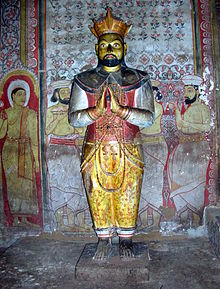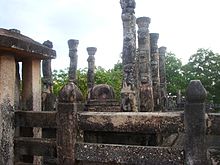- Nissanka Malla of Polonnaruwa
-
Nissanka Malla
(Kalinga Lokesvara)King of Sri Lanka 
Statue of Nissanka Malla in the Dambulla cave templeReign 1187–1196 Born 1157 or 1158 Birthplace Sinhapura Died 1196 Predecessor Mahinda VI Heir-Apparent Vira Bahu I Successor Vira Bahu I Consort Kalinga Subadradevi
Gangavamsa KalyanamahadeviWife Kalyanavati Offspring Vira Bahu I Dynasty House of Kalinga Father Jayagopa Mother Parvati Nissanka Malla (Sinhala, නිස්සංක මල්ල), also known as Kirti Nissanka and Kalinga Lokesvara was a king of Sri Lanka who ruled the country from 1187 to 1196.[1] He is known for his architectural constructions such as the Nissanka Lata Mandapaya, Hatadage and Rankot Vihara, as well as for the refurbishment of old temples and irrigation tanks.
Nissanka Malla declared that only a Buddhist had the right to rule the country, thereby securing his position and justifying his claim for kingship. He spent large sums for various constructions and refurbishments, and also gifted money to the public in an attempt to put down crimes. He maintained cordial relationships with several countries, and also invaded the states of the Pandyans and Cholas in South India.
Contents
Ancestry and family
A rock inscription made by Nissanka Malla at Dambulla mentions that he is of the Kalinga Dynasty and a descendant from the race of King Vijaya. Another inscription at Ruwanwelisaya describes him as being a member of a royal family of Kalinga, born at Sinhapura. The inscription there reads;[2]
...having come from the royal line of the Ikshvaku family having become like a forehead mark to the royal family of Kalinga emperors born at Sinhapura...Nissanka Malla's year of birth is 1157 or 1158.[3] He was the son of Queen Parvati and King Jayagopa. This is mentioned in a rock inscription made by Nissanka Malla at Galpota. This inscription describes Jayagopa as being the reigning king of Sinhapura. Nissanka Malla had two wives named Kalinga Subadradevi and Gangavamsa Kalyanamahadevi.[2] He was also a son-in-law or nephew of Parākramabāhu I.[3]
Reign
Nissanka Malla came to Sri Lanka under the invitation of Vijayabâhu II, who succeeded Parākramabāhu the Great, and was appointed as Vijayabâhu's Aepa (sub-king).[2] Vijayabâhu was killed by Mahinda VI of the Kalinga Dynasty. Mahinda VI reigned for only five days before Nissanka Malla killed him and assumed the throne himself in 1187.[4]
By claiming to be descended from Vijaya, the first king of Sri Lanka, Nissanka Malla justified his right to the throne.[3] He secured his position further by declaring that the ruler of Sri Lanka should adhere to Buddhism.[5] His rock inscription at Galpotha describes this, saying that "non-Buddhists should not be placed in power in Sri Lanka to which the Kalinga dynasty was the rightful heir".[6]
He is also known as Kirti Nissanka and is referred to in some records as Kalinga Lankesvara. His rock inscriptions refer to him in names such as "Fountain of renown", "Protector of the Earth" and "Lamp by which the whole world was illuminated".[7]
Economy
Heavy taxes that were imposed by Parākramabāhu I were largely reduced by Nissanka Malla.[3] He gifted money, gold, cattle, land and other items of value to the public. This was seen by him as an act to "put down robbery", since he believed that they resorted to robbery because of oppression and severe taxation.[8] However, Nissanka Malla tried to outdo the accomplishments of Parākramabāhu I with his constructions, which later led the kingdom becoming almost bankrupt.[9]
Foreign relations
Nissanka Malla had cordial relationships with Ramanna (Burma). He also maintained relationships with remote countries such as Rajputna and Cambodia. Rameswaram of South India, which had come under the control of Sri Lanka during the reign of Parākramabāhu I, continued to be part of Sri Lankan kingdom during the reign of Nissanka Malla as well. Nissanka Malla renovated a temple in Rameswaram and renamed it Nissankesvara.[10] Nissanka Malla also invaded the states of the Pandyans and Cholas in South India.[6][11]
Constructions
The Nissanka Latha Mandapaya, constructed by Nissanka Malla is a unique type of building. It contains 8 granite pillars which were used to support a roof.[12] The pillars are carved out of granite in the form of lotus stems with opening lotus buds on the tops, and are positioned on a platform.[13]
The Hatadage is another construction done by Nissanka Malla.[13] This building was constructed to keep the Relic of the tooth of the Buddha.[14] The Rankot Vihara, the fourth largest stupa in Sri Lanka, was also constructed by Nissanka Malla.[1]
A major refurbishment was carried out at the Dambulla cave temple by Nissanka Malla. A rock inscription records that he has spent 7 lakhs for this. However, another of his own rock inscriptions contradict this statement and mentions the sum as 1 lakh.[8] The interior of the temple was gilded during the refurbishment. This later earned the temple the name Ran Giri, meaning golden rock. Nissanka Malla also had 50 Buddha statues in the temple gilded, and had this recorded in a rock inscription near the entrance of the temple.[15] A statue of Nissanka Malla was also made in one of the caves.[16]
See also
References
- ^ a b "The largest dagoba in Polonnaruwa". Sunday Observer. 2005-05-08. http://www.sundayobserver.lk/2005/05/08/juniorob04.html. Retrieved 2009-04-11.
- ^ a b c Rasanayagam, C.; Aiyangar, Sakkottai Krishnaswami (1993). Ancient Jaffna. Asian Educational Services. pp. 322, 323. ISBN 8120602102. http://books.google.lk/books?id=k9DpMY206bMC&pg=PA322&lpg=PA322&dq=Nissanka+Malla&source=bl&ots=5YlWEMZRY3&sig=EjQfr2kGbS-NYcolSZRd23mInPE&hl=en&ei=WULgSb23G8-AkQWjv_jRCw&sa=X&oi=book_result&ct=result&resnum=10. Retrieved 2009-04-11.
- ^ a b c d Codrington, H. W. (1995). Short History of Ceylon. Asian Educational Services. pp. 65. ISBN 8120609468. http://books.google.lk/books?id=tqpdlaPiOyEC&pg=PA65&lpg=PA65&dq=Nissanka+Malla&source=bl&ots=_rFlqARx9-&sig=LtCaCT92YmoCnQDXdmS2x9Bo3ME&hl=en&ei=skPgSdmfPMiMkAWDu-DQCw&sa=X&oi=book_result&ct=result&resnum=4#PPA65,M1. Retrieved 2009-04-11.
- ^ Wijesooriya, S. (2006). "53". A Concise Sinhala Mahavamsa. Participatory Development Forum, Sri Lanka. pp. 126. ISBN 9559140310.
- ^ Strathern, Alan (2007). Kingship and Conversion in Sixteenth-Century Sri Lanka. Cambridge University Press. pp. 147. ISBN 0521860091. http://books.google.lk/books?id=LTYnb_wVU34C&pg=RA1-PA147&lpg=RA1-PA147&dq=Nissanka+Malla&source=bl&ots=TV3jVZ9xNp&sig=8OaAMyJgOG_unRYiO5pSMfn1bJs&hl=en&ei=skPgSdmfPMiMkAWDu-DQCw&sa=X&oi=book_result&ct=result&resnum=7#PRA1-PA147,M1. Retrieved 2009-04-12.
- ^ a b "The Kingdom of Polonnaruwa". Educational Publications Department, Sri Lanka. http://www.edupub.gov.lk/Final%20History%20Grade%207%20%2010.04.2008(Eng)/Chapter%204.pdf. Retrieved 2009-04-12.
- ^ Wright, Arnold (1999). Twentieth century impressions of Ceylon. Asian Educational Services. pp. 38. ISBN 812061335X. http://books.google.lk/books?id=eUF_rS8FEoIC&pg=PA38&lpg=PA38&dq=Nissanka%2BRamanna&source=bl&ots=IhfMmMfQki&sig=bb4uF9OxcXuSz0XeqEeG5Kv2WGc&hl=en&ei=bIfhSdfHFJSHkAXA5ZTOCw&sa=X&oi=book_result&ct=result&resnum=7#PPA38,M1. Retrieved 2009-04-12.
- ^ a b Davids, T.W.Rhys (1996). International Numismata Orientalia. Asian Educational Services. pp. 23. ISBN 8120611888. http://books.google.lk/books?id=sstuEs85X0wC&pg=PA24&lpg=PA24&dq=Nissanka+Malla&source=bl&ots=O0iLxXpUol&sig=LmiVKNgkEFUKIr_eMfrLfplmBkU&hl=en&ei=skPgSdmfPMiMkAWDu-DQCw&sa=X&oi=book_result&ct=result&resnum=1#PPA23,M1. Retrieved 2009-04-12.
- ^ Paxton, Hugh; Paxton, Midori (2002-09-10). "Studying Sri Lanka's simian soap opera". The Japan Times Online. http://search.japantimes.co.jp/cgi-bin/fv20020910hm.html. Retrieved 2009-04-14.
- ^ Mendis, G.C. (1996). Early History of Ceylon. Asian Educational Services. pp. 65, 66. ISBN 8120602099. http://books.google.lk/books?id=PVrUcdi4ZikC&pg=PA65&lpg=PA65&dq=Nissanka+Malla&source=bl&ots=_G_4jO_CXO&sig=4xzfPTgDnxAtS3VGV8bS4Czy1ZE&hl=en&ei=WULgSb23G8-AkQWjv_jRCw&sa=X&oi=book_result&ct=result&resnum=1#PPA66,M1. Retrieved 2009-04-12.
- ^ Peebles, Patrick (2006). The history of Sri Lanka. Greenwood Publishing Group. pp. 21, 23. ISBN 0313332053. http://books.google.lk/books?id=SxO0eISluqEC&pg=PA21&lpg=PA21&dq=Nissanka+Malla&source=bl&ots=9hbkV_Tj_e&sig=LRYEsGaUDTvqyEu25am216OXVOM&hl=en&ei=wEHgSZOrFISMkAXtiaDUCw&sa=X&oi=book_result&ct=result&resnum=9. Retrieved 2009-04-12.
- ^ Coomaraswamy, Ananda K. (2003). History of Indian and Indonesian Art. Kessinger Publishing. pp. 165. ISBN 0766158012. http://books.google.lk/books?id=_JPmp2aAQdcC&pg=PA165&lpg=PA165&dq=Nissanka%2Bmandapaya&source=bl&ots=p-0sJoQVs8&sig=XXAhhvN-EDzqEinSpdU3oUINYow&hl=en&ei=3cfhSc-KL82UkAXY37ndCw&sa=X&oi=book_result&ct=result&resnum=6#PPA165,M1. Retrieved 2009-04-12.
- ^ a b Isenberg, Joan P.; Renck, Mary (2003). Major Trends and Issues in Early Childhood Education. Teachers College Press. pp. 75, 76. ISBN 080774350X. http://books.google.lk/books?id=65gegDaEsToC&pg=PA75&lpg=PA75&dq=Nissanka%2Bmandapaya&source=bl&ots=NdHtwcVmbU&sig=AuXrBINfxR-sJYa7WBQB29VL760&hl=en&ei=3cfhSc-KL82UkAXY37ndCw&sa=X&oi=book_result&ct=result&resnum=9#PPA76,M1. Retrieved 2009-04-12.
- ^ Witharanage, Hansima (2007-02-14). "Sacred Tooth Relic; a journey from Kalinga in India to Senkadagalapura Temple of Tooth.". The Official Government News Portal of Sri Lanka. http://www.news.lk/index.php?option=com_content&task=view&id=1744&Itemid=52. Retrieved 2009-04-12.
- ^ Pradeepa, Ganga (2008-10-24). "Dambulla - Best preserved cave temple complex". Daily News. http://www.dailynews.lk/2008/10/24/fea11.asp. Retrieved 2009-04-12.
- ^ "The cave temples of Dambulla". Sunday Observer. 2004-11-07. http://www.sundayobserver.lk/2004/11/07/juniorob05.html. Retrieved 2009-04-12.
External links
Nissanka Malla of PolonnaruwaHouse of KalingaBorn: ? 1157 or 1158 Died: ? 1196Regnal titles Preceded by
Mahinda VIKing of Polonnaruwa
1187–1196Succeeded by
Vira Bahu IMonarchs of the Kingdom of Polonnaruwa House of Vijayabahu
(1056–1187, 1197-1200, 1209-1210, 1211-1212)Vijayabahu I (1056–1111) · Jayabahu I (1110–1111) · Vikramabahu I (1111–1132) · Gajabahu II (1131–1153) · Parakramabahu I (1153–1186) · Vijayabahu II (1186–1187) · Mahinda VI (1187–1187) · Lilavati (1197-1200, 1209-1210, 1211-1212)House of Kalinga
(1187–1197, 1200–1209)Nissanka Malla (1187–1196) · Vira Bahu I (1196–1196) · Vikramabahu II (1196–1196) · Chodaganga (1196–1197) · Sahassa Malla (1200–1202) · Kalyanavati (1202–1208) · Dharmasoka (1208–1209) · Anikanga (1209–1209)Lokissara, Pandyan Dynasty and Kalinga (India)
(1210-1211, 1212–1236)Lokissara (1210-1211) · Parakrama Pandya (1212–1215) · Kalinga Magha (1215–1236)Categories:- Kings of Sri Lanka
Wikimedia Foundation. 2010.

